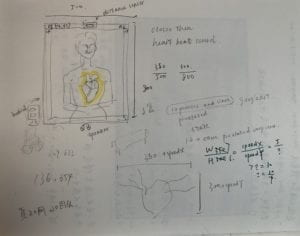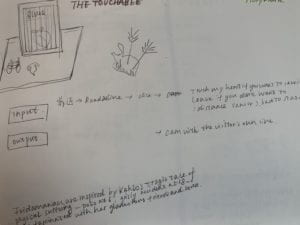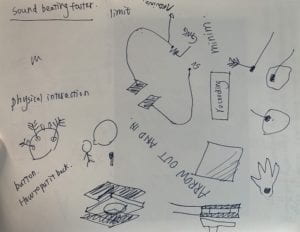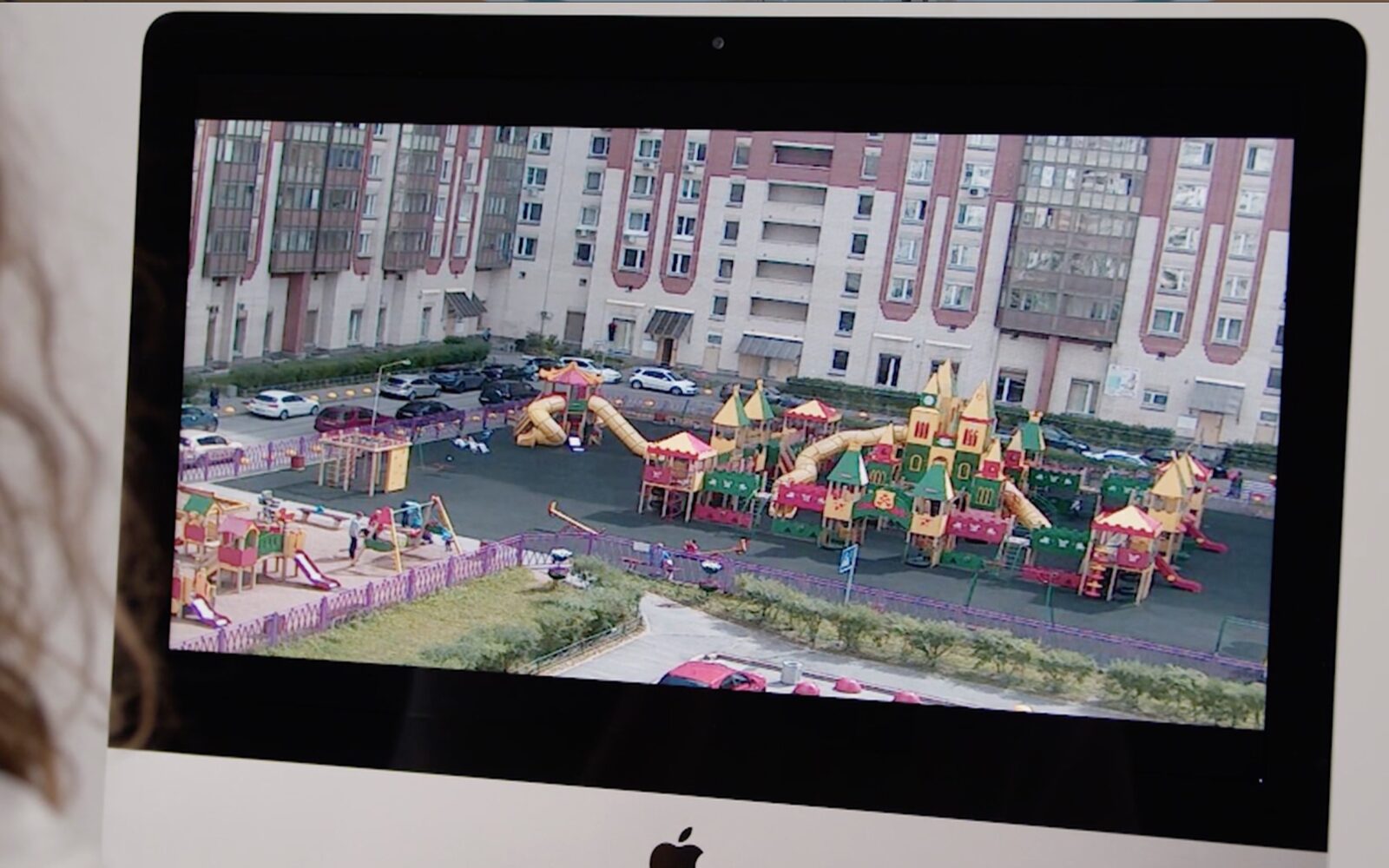Introduction
My project is called “feel me, catch me,” which is a game model. In this game model, there are three kinds of players, devil, angel, and ordinary people. Angel player’s task is to find the devil player; at the same time, the devil player’s mission is to find the angel player. Ordinary people don’t have a task. They will continuously move around during the game, interference with the identification of angels and devils. Because each player doesn’t know who the other player is, the angel and devil recognize each other by listening to background music (which is why it’s called catch me, feel me).Each player holds a game box. As the angel approaches the demon, the background music continues to produce a heartbeat, and the heart image on the computer continues to beat.
Because this project is a model, the complete game version can be applied to life as an ice-breaking game. For example, this game can be played in school, at this time only angel players and devil players, while ordinary players are students who do not participate in the game. The play site is the whole school, and angel and demon players will wear Bluetooth headphones, which will be connected to the computer. When they get close to each other, they will hear intense heart beatings in the earphones. Whoever recognizes the other’s identity first, namely shout out “catch you,” who wins.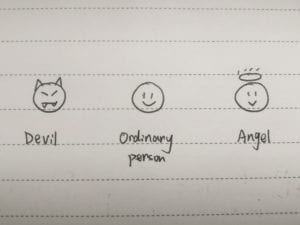
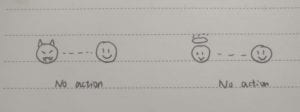

In what ways did your understanding of how your users were going to interact with your project informed certain design decisions you made?
In this work, the most critical decision I made was to establish the connection between players, instead of the interaction between players and the machine. In real life, we spend most of our time communicating through eye contact and oral communicating, but we ignore the role of listening. So I want to use “hearing the heartbeat to judge each other identity” as a new way to build a new kind of interaction between players. When the angel and the demon get close to each other, both two sides will hear intense heartbeats. This design goes beyond the purely visual influence but adds more hearing element. Also, this design goes beyond the connection between the player and the machine, establishing a relationship between players and players directly.
what form, material or elements did you use? What criteria did you use to select those materials? Why was it/were they best suited to your project purpose, more than any other one/s? What might have been another option? But you rejected it—why?
In this work, my primary materials are radio frequency link, Arduino nano, and power bank.
Radio frequency link:
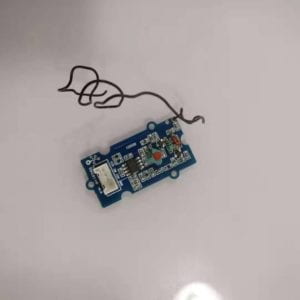
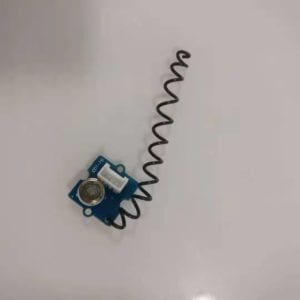
(receiver) (sender)
The most important reason for using a radio frequency link is pairing. That is, the sender sends a signal, such as “hello,” and the receiver can receive many signals. Still, it only responds when it receives “hello.” In this work, I used two sets of receiving and sending terminals in total, one for matching devil and angel, and the other for matching devil and computer. The computer connected to a receiver, the devil box had a receiver and sender, and the angel box had a sender. The sender in the angel box keeps sending “hello”.

But only when the receiver of the devil box receives the “hello” signal, the sender of the devil box will send another specific message “ghost” to the computer, indicating that the devil and angel have matched so that the Processing can start.
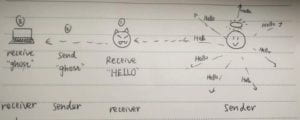
the receiver of the computer receives the “ghost” and completes the heartbeat instruction through the Arduino to processing program.

In the beginning, I was hesitant to choose Bluetooth or rf, because both can use to match, but I decided rf at last for two reasons. The first reason is that the radio frequency distance is very long, which can reach 40m~100m, which means that the game range can be broader. However, the stable Bluetooth range is only 3m to 10m. The second reason is that Bluetooth pairing can only be one-to-one, but rf is not limited to one-to-one matching. Rf receiver can receive multiple signals, which means that a demon (receiver) can accept various angel (sender) signals so that more players can be added to the game.
Arduino nano
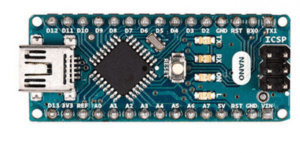
Compared with uno, nano is smaller in size, but with full functions and is easy to carry, so nano was chosen instead of uno.
Power bank
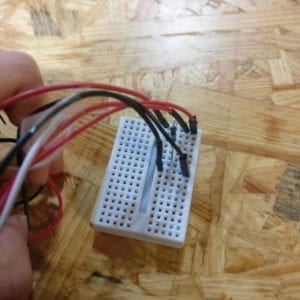
The power bank can provide independent power to nano. However, the power bank has a disadvantage that it needs a specific resistance to provide a constant power supply. So I connected a 220-ohm resistance to the breadboard so that the power bank can provide continuous power supply to nano.
- FABRICATION AND PRODUCTION:
the most significant steps in your production process, both in terms of failures and successes.
Using radio frequency link as pairing is one of the most critical steps in production. I used the Bluetooth pairing between the player’s device at the beginning. I then used the radio frequency link as the connection between the computer and the player.
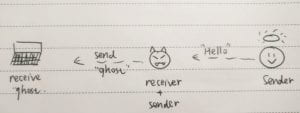
But during the User Testing Session, one of my classmates suggested I can add more players into the game. In this case, the Bluetooth’s one-to-one match is not appropriate. I need a device that can send and receive a particular signal. I consulted a faculty of IMA, she recommended me to use radio frequency link, because its sender can emit a specific message, but the receiver is not one-to-one matched. As long as the specified signals can be recognized, it can be paired. At the same time, the radio frequency link can reach a distance of 40m~100m, which is similar to my game design. Therefore, after the user testing session, I gave up using Bluetooth and used radio frequency link as my main element.
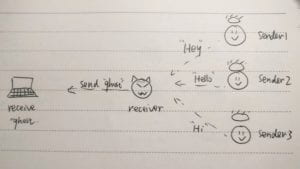
When I used radio frequency link to do works, there was a relative failure that troubled me for a long time: there would be mutual influence between the senders of radiofrequency link at a close distance so that the receiver might confuse the two signals. That is: there is a sender in the angel’s box. The demon box at the same time also has a sender to send signals to the computer. The computer has a receiver, while it is possible to distinguish the signal of the demon box. Still, because of the interference of the angel’s box signal, the receiver is often disturbed. On the control panel of the Arduino, there often appear signals that should not be received, leading to the wrong action of the processing. To solve this problem, I optimized the Arduino code of the computer’s receiver. Previously, my code was to generate specific effects for processing when the computer receiver received the signal from the devil box. The optimized code means that when receiving the signal from the angel box, no operation is generated. When receiving the signal from the devil box, Processing is performed. In other cases, no actions are made. After this optimization, the Arduino didn’t give the wrong instructions because it recognizes the signal separately.
How do your project results align with your definition of interaction? How do your project results not align with your definition of interaction?
My goal is to build interaction between people by using machines as a bridge in the form of games. After a semester’s study, my definition of interaction gradually changed from the four mechanical steps at the beginning to focus on the interaction between people. In my opinion, when people interact with machines, they should pay more attention to the interaction between people, and machines should act as a bridge to promote interaction or connection between people. My model of the game wants players to connect through machines, but their attention isn’t on the machines, it’s on the players. They can identify each other by the box containing the machine. Still, in order to win the game in the end, one of them needs to shout “catch you,” which means that the two parties are no longer independent existence, but build a kind of connection based on the machine. This is what I called interaction. The machine is an essential medium here. Still, the ultimate purpose of the product is to allow players to recognize each other and interact with each other.
Based on both your definition of interaction and your expectation of your audience’s response, how, ultimately, did your audience interact with your project?
During the presentation, because a wire of the devil box disconnected accidentally, the effect did not play out. But at the time of the IMA show, I invited four players to experience the game. They don’t know how to play at first, but after explaining the rules, they are scattered in the classroom and began to walk. When the demon player and angel player approached, the computer made a loud heartbeat. Still, when they separated, the heartbeat stopped. At this point, the demon player immediately locks on to the player who approached him, then walks up and says, “catch you” and wins the game. The results were similar to what I expected. Still, there were some differences because the ordinary player (has no special missions) was moving back and forth, so they didn’t enjoy themselves.
Moreover, the devil player quickly finds the angel player, which is also different from what I imagined, so the interaction is not reflected. In my opinion, this problem mainly arises from the fact that this project is only a model rather than a real game. In the actual game, the identity of the ordinary player is the students who are not participating in the game, so they do not have a sense of game experience. At the same time, if you play this game in real life, there will be a lot of uncertainty, so the devil or angel will not quickly identify each other’s identity.
How would you improve your project if you had more time?
If I had more time, I would have constructed a complete game and planned a more specific rating rule. For example, if the angels want to win the game, they need to identify all the demons and send their names to the computer. If the angel finds all the names first and there are no mistakes, then angel wins. But if there’s a mistake in the name, they lose. Such ratings make the game more exciting and complete.
What value have you learned from any setbacks and/or failures? What do you take away from your accomplishments?
This is the only big project I’ve done on my own this semester. Without my previous dependence on my peers, I need to be responsible for myself, take responsibility and consequences on my own. Because cooperating with my classmates, I used to feel my partner can share the burden, or when it is close to the deadline, we can depend on each other. But this time is different, this time I only have myself, I need to create the plans by myself – how to arrange the time, do research or ask information from the faculty. Although it is hard and tedious for me to work along, the excitement and thrill can’t be described when my project is successful. It is the happiest thing I feel. At that moment, I felt that all my efforts were worthy. I think this is the most important lesson I have learned from this project.
In this high-tech age, people are more and more immersed in the interaction with electronic products such as mobile phones and computers, while ignoring the most direct communication between people. Machinery, no longer as a tool, but as an interactive partner, replaced the role of “human.” Maybe this is the current trend in society, but I still want to make a little change of myself. I think the interaction should be based on the human-mechanical, but the goal is the human-human interaction. And the machinery should be just a medium or a bridge. Although we can interact with the mechanism, we should still feel the existence of people behind the machinery and the emotions and intentions of the people who created the machinery. “To communicate with people through machinery”——this is my understanding of the interaction and the original purpose of my product design. It is also my most significant gain in this course.












